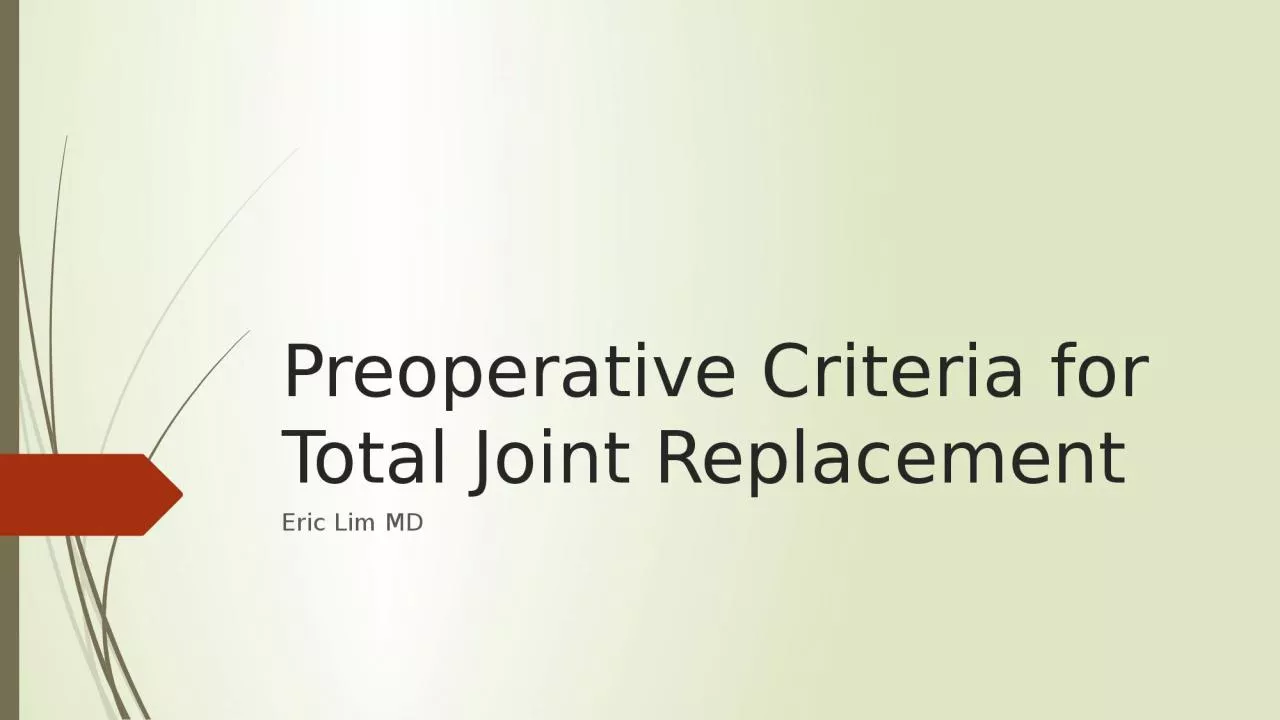

Eric Lim MD Disclosures No Conflicts of interest This is not an exhaustive talk Overview Brief Overview of HipKnee Arthritis Nonoperative and Operative Treatment of Arthritis Complications of Joint Replacement ID: 1000709
Download Presentation The PPT/PDF document "Preoperative Criteria for Total Joint Re..." is the property of its rightful owner. Permission is granted to download and print the materials on this web site for personal, non-commercial use only, and to display it on your personal computer provided you do not modify the materials and that you retain all copyright notices contained in the materials. By downloading content from our website, you accept the terms of this agreement.
1. Preoperative Criteria for Total Joint ReplacementEric Lim MD
2. DisclosuresNo Conflicts of interestThis is not an exhaustive talk
3. Overview Brief Overview of Hip/Knee ArthritisNon-operative and Operative Treatment of ArthritisComplications of Joint ReplacementPre-operative Requirements
4. Why Total Joint Replacement?OsteoarthritisRheumatoid ArthritisPost-traumatic ArthritisLoss of Articular Cartilage
5. Arthritis: -leads to pain, ligamentous contractures/laxity, joint deformityIncidence: Hand: 100 per 100,000 Hip: 88 per 100,000 Knee: 240 per 100,000
6. OsteoarthritisRisk Factors1. Modifiable: obesity, trauma, occupation (hard labor), muscle weakness2. Non-modifiable: gender (female>male), age, genetics, racehttp://msdlatinamerica.com/ebooks/ChapmansOrthopaedicSurgery/sid1315243.html
7. OA statisticsIn 2010-2012, 49.7% of adults 65 years or older reported an arthritis diagnosis. 66% of adults with doctor-diagnosed arthritis are overweight or obese (compared with 53% of adults without doctor-diagnosed arthritis).Weight loss of as little as 11 pounds reduces the risk of developing knee osteoarthritis among women by 50%.Among older adults with knee osteoarthritis, engaging in moderate physical activity at least 3 times per week can reduce the risk of arthritis-related disability by 47%.In 2003, the total cost attributed to arthritis and other rheumatic conditions in the United States was 128 billion dollars, up from 86.2 billion dollars in 1997.Very Common, Very Expensivehttp://www.cdc.gov/arthritis/data_statistics/arthritis_related_stats.htm
8. Osteoarthritis: XRAY findingsJoint space narrowingOsteophytesSubchondral sclerosisSubchondral cystshttp://www.drmichaelwind.com/knee-surgery/total-knee-arthroplasty
9.
10. Symptoms-Dull, aching pain in knee or groin-Remember hip arthritis can cause knee pain, knee arthritis can cause hip pain-Lumbar degenerative disease can cause both hip and knee pain-Patient who complains of “hip pain” but points to the buttock should initially be worked up for lumbar degenerative disease
11. Workup/xraysInclude Pelvis xray for hip painInclude bilateral standing knee xrays. May get a 20 degree flexed PA viewConsider lumbar spine xray/MRIIf significant hip or knee arthritis on xray…MRI unnecessary
12. OA Non-operative TreatmentNSAIDSWeight lossExercise/Physical therapyBracingCorticosteroid injectionsViscosupplementary injectionshttp://www.rheumatologynetwork.com/articles/joint-aspiration-and-injection-look-basics
13. Management of Osteoarthritis of the Knee (Non-Arthroplasty) (3rd Edition)Lateral Wedge Insoles –Not recommended, Strong evidenceCanes—Recommended, Moderate evidenceBraces—Recommended, Moderate evidenceTopical Treatments—Recommeneded, Strong EvidenceSupervised Exercise—Recommmended, Strong evidenceNeuromuscular Training—Recommended, Moderate evidenceSelf Management—Recommended, Strong evidencePatient Education—Recommended, Strong evidenceWeight Loss Intervention—Recommended, Moderate evidenceManual Therapy—Limited evidenceMassage—Limited evidenceLaser Treatment—Limited evidenceAccupuncture—Limited evidencePercutaneous Electrical Nerve Stimulation—Limited evidenceExtracorporeal Shockwave Therapy—Limited evidenceOral NSAIDS—Recommended, Strong evidenceOral Acetaminophen—Recommended, Strong evidenceOral Narcotics—Not recommended, Strong evidenceHyaluronic Acid—Not Recommended, Moderate evidenceIntra-articular Corticosteroids—Recommended, Moderate evidencePlatelet-rich Plasma—Limited evidenceDenervation Therapy—Limited evidenceLavage/Debridement—Not Recommended, Moderate evidenceTibial Osteotomy—Limited EvidenceDry Needling—No Reliable Evidence, consensusFree-Floating Interpositional Devices—Not recommeneded, consensusAmerican Academy of Orthopaedic Surgeons Management of Osteoarthritis of the Knee (Non-Arthroplasty) Evidence-Based Clinical Practice Guideline (3rd Edition). https://www.aaos.org/oak3cpg Published August 31, 2021.Accessed March 15, 2022
14. OA Operative TreatmentArthroscopic debridement?High tibial OsteotomyUnicompartmental (partial) knee replacementTotal joint replacementhttp://www.kneeandhipsurgery.co.in/high-tibial-osteotomy.html
15. Joint Replacement
16. Total Joint Replacement700,000 Total Knee Replacements per year 300,000 Total Hip Replacements per yearNumbers expected to increase as US population ages
17. Complications in TKA1. Infection2. Blood clots/embolism3. Instability4. Vascular injury5. Blood loss6. Nerve palsy7. Stiffness8. Extensor mechanism rupture9. Wound complications10. Metal hypersensitivity11. Fractureshttp://www.healio.com/~/media/Journals/ORTHO/2012/1_January/10_3928_01477447_20120222_14/fig1.ashx
18. Complications in THA1. Infection2. Blood clots/embolism3. Dislocation4. Peri-prosthetic fracture5. Nerve Palsy6. Leg-length discrepancy7. Osteolysis8. Pseudotumor
19. Complications of Joint Replacement: InfectionDevastating problemAffects 1 – 7% of all joint replacementsCost $50,000+ per infectionEstimate that by 2030, 38,000 to 270,000 joint infections can be expected annually
20. Total knee Complications: INFECTIONRisk factors -obesity -prior surgery -diabetes -smoking -inflammatory arthritishttp://www.orthobullets.com/recon/5023/tka-complicationshttp://jbjs.org/content/95/8/e50
21. Infection: Glycocalyx and BiofilmMicrobes preferentially adhere to “inert biomaterials”Glycocalyx is similar to the “slime-layer” on the outside of a fishAntibiotics cannot penetrate this slime-layerTherefore, often only way to get rid of infection is to remove the metalhttp://en.wikipedia.org/wiki/Glycocalyx
22. Once biofilm forms, only way to get rid of it is to EXPLANT knee replacementTwo-stage re-implantationVery high morbidityVery expensiveCan lead to above knee amputation
23. InfectionAntibiotic spacerInvolves removing all metal and plastic componentsPlacing a temporary, antibiotic-impregnated spacer deviceOften associated with significant bone lossSeverely affects patient’s ability to be mobile, activehttp://www.hindawi.com/journals/crior/2012/147042/fig3/
24. CMS “NEVER EVENTS” 2008
25. History at ANMCIn 2006-2007, ANMC experienced a “cluster” of postoperative infections following Total Joint replacements6 infections for a rate of 2.9%CDC did a formal investigationJoint replacement program temporarily shut downMultiple recommendations/changes made
26. The Numbers…-Accepted infection rate is <1%ANMC was shut down for infection rate 2.9%-BMI >40, relative risk of infection 3.68-Smoking relative risk of infection 1.38-1.83MODIFIABLE RISK FACTORS!
27. Preoperative Criteria for Total JointOptimize Risk Factors, especially the modifiable onesBody Mass Index, weight lossDM managementSmoking
28. BMI > 50 OR for infection 21.3BMI > 40 OR for infection 3.68DM patients 3x higher infection rates
29. SmokingSmoking cessation reduces risk ofCardiopulmonary complicationsWound related complicationsSecondary surgeryOverall Complication ratesMoller et al., Effect of preoperative smoking intervention on postoperative complications: a randomized clinical trial. The Lancet Vol 359, Issue 9301. 2002: 114-117.
30. Preoperative Screening Lowers Infection and Complication RatesTotal complication rate reduced from 35.4% to 14.8% (P<0.01) after implementation of screening criteriaSurgical Site Infection rates reduced from 4.4% to 1.3% (P<0.01)Nussenbaum et al, Implementation of preoperative screening criteria lowers infection and complication rates following elective total hip arthroplasty and total knee arthroplasty in a veteran population. The Journal of Arthroplasty 33 (2018) 10-13.
31. Preoperative Screening CriteriaMost patients (87%) required less than a year to meet criteria Most patients (76%) “relapse” to their previous, non-qualifying status after surgeryThis reversion did not contribute to increased rate of complication (P = 0.43)Stiegel, et al. Analysis of preoperative screening criteria for total joint arthroplasty in a veteran population. The Journal of Arthroplasty 35 (2020) S119-S123.
32.
33.
34.
35. ConclusionIn the right patient, joint replacement is one of the most successful surgeries in orthopedicsIn the wrong patient, joint replacement can be devastating